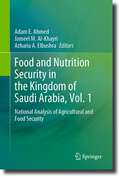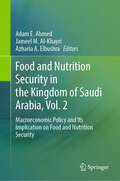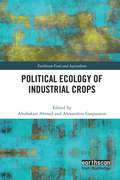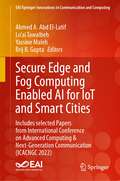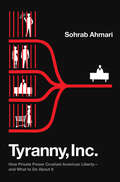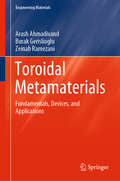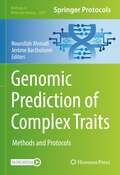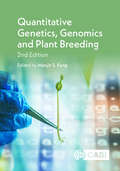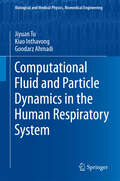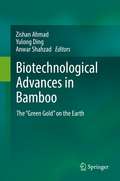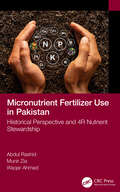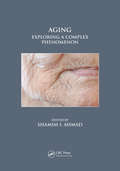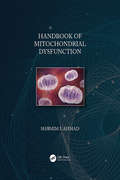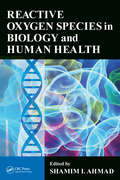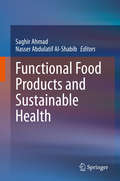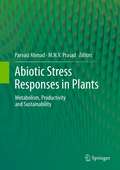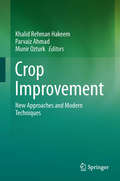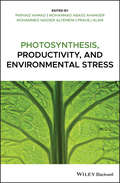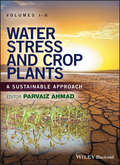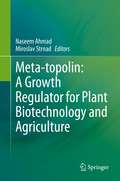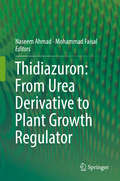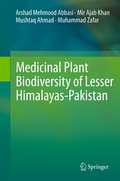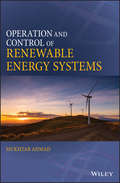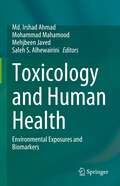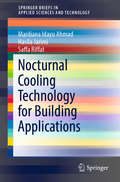- Table View
- List View
Food and Nutrition Security in the Kingdom of Saudi Arabia, Vol. 1: National Analysis of Agricultural and Food Security
by Adam E. Ahmed Jameel M. Al-Khayri Azharia A. ElbushraFood and nutrition security is a major concern for Saudi Arabia and the surrounding regions due to the range of challenges they face. These challenges include limited agricultural resources, low self-sufficiency in key food staples, climate change, and high levels of food loss and waste. This book aims to evaluate and analyze the current situation and future prospects of food and nutrition security in Saudi Arabia. Additionally, it seeks to analyze and assess the roles and functions of various institutions related to food security, providing a deeper understanding of the complex problems associated with it. Furthermore, this book aligns with Kingdom Vision 2030, which includes a set of strategies and programs focused on agriculture, food, and water security. It also aligns with the institutional identity of King Faisal University's "Food Security and Environmental Sustainability".The book consists of four volumes. Volume 1, entitled "National Analysis of Agriculture and Food Security" aims to assess the current state of food security in Saudi Arabia, covering key aspects such as agriculture and food resources, food systems, crops, livestock, poultry, fisheries, animal health, food loss and waste, transportation and strategic reserve infrastructure, food security institutions, population, agricultural extension, climate change, agricultural mechanization, smart agriculture, and the utilization of solar energy.This book is highly significant for professionals, researchers, policymakers, and entrepreneurs involved in food and nutrition security in Saudi Arabia, the Gulf Cooperation Council, and various national and international organizations. It offers a comprehensive analysis of the obstacles and possibilities in ensuring food and nutrition security, as well as presenting practical approaches to address these issues. Additionally, graduate students studying in fields related to food and nutrition security will benefit from this book.
Food and Nutrition Security in the Kingdom of Saudi Arabia, Vol. 2: Macroeconomic Policy and Its Implication on Food and Nutrition Security
by Adam E. Ahmed Jameel M. Al-Khayri Azharia A. ElbushraFood and nutrition security is a major concern for Saudi Arabia and the surrounding regions due to the range of challenges they face. These challenges include limited agricultural resources, low self-sufficiency in key food staples, climate change, and high levels of food loss and waste. This book aims to evaluate and analyze the current situation and future prospects of food and nutrition security in Saudi Arabia. Additionally, it seeks to analyze and assess the roles and functions of various institutions related to food security, providing a deeper understanding of the complex problems associated with it. Furthermore, this book aligns with Kingdom Vision 2030, which includes a set of strategies and programs focused on agriculture, food, and water security. It also aligns with the institutional identity of King Faisal University's "Food Security and Environmental Sustainability".The book consists of four volumes. Volume 2 is entitled "Macroeconomic Policy Implications on Food and Nutrition Security". It covers various areas, including food price, loss and waste, processing, finance, trade, investment, quality and safety, consumption patterns, climate change, early warning systems, nutrition institutions, oil revenue, and the significance of date palm and Hassawi rice, genetically modified food, and edible insects in ensuring food and nutritional security.This book is highly significant for professionals, researchers, policymakers, and entrepreneurs involved in food and nutrition security in Saudi Arabia, the Gulf Cooperation Council, and various national and international organizations. It offers a comprehensive analysis of the obstacles and possibilities in ensuring food and nutrition security, as well as presenting practical approaches to address these issues. Additionally, graduate students studying in fields related to food and nutrition security will benefit from this book.
Political Ecology of Industrial Crops (Earthscan Food and Agriculture)
by Abubakari AhmedThis book employs a political ecology lens to unravel how industrial crops catalyse ecological, agrarian, socioeconomic, and institutional transformation. Using the conceptual tools and perspectives of political ecology, namely multi-scalar analysis and attention to marginalisation, social difference, and discourses and narratives, this volume provides a critical and comprehensive assessment of the transformative power of industrial cropping systems. It presents a truly international overview by drawing on a range of case studies from the global South, including soybeans in South America, cashew nuts in Guinea Bissau, cotton in India, maize in China, jatropha in Ghana, sugarcane in Peru and Eswatini, and oil palm in Ghana and Peru. The unique case studies are put into perspective with chapters introducing the key concepts of political ecology and critical dimensions of industrial cropping systems related to large-scale land acquisitions, land grabbing, and marginal land. The individual chapters employ different approaches all rooted in political ecology, thus offering a rich overview of how the field engages with such cropping systems. Overall, this volume contains valuable propositions for improving current policies and practices in industrial crop settings in both developed and developing countries. Through its comprehensive and interdisciplinary outlook, this volume will be of great interest to students and scholars of political ecology, agrarian studies, development studies, and ecological economics.
Secure Edge and Fog Computing Enabled AI for IoT and Smart Cities: Includes selected Papers from International Conference on Advanced Computing & Next-Generation Communication (ICACNGC 2022) (EAI/Springer Innovations in Communication and Computing)
by Ahmed A. Abd El-Latif Lo’ai Tawalbeh Yassine Maleh Brij B. GuptaThis book gathers recent research in security and privacy to discuss, evaluate, and improve the novel approaches of data protection in IoT and edge and fog computing. The primary focus of the book addresses security mechanisms in IoT and edge/ fog computing, advanced secure deployments for large scaled edge/ fog computing, and new efficient data security strategy of IoT and edge/ fog computing. The book lays a foundation of the core concepts and principles of IoT and 5G security, walking the reader through the fundamental ideas. This book is aimed at researchers, graduate students, and engineers in the fields of secure IoT and edge/ fog computing. The book also presents selected papers from International Conference on Advanced Computing & Next-Generation Communication (ICACNGC 2022).
Tyranny, Inc.: How Private Power Crushed American Liberty--and What to Do About It
by Sohrab AhmariThe inside story of how our political class enabled an era of unaccountable corporate might that left ordinary Americans isolated and powerless—and how we can fight back—from the acclaimed author of The Unbroken Thread&“In Tyranny, Inc., Sohrab Ahmari, one of the leading thinkers of our time, alerts us to one of the greatest threats to freedom.&”—Michael Lind, author of The New Class War and Hell to PayOver the past two generations, U.S. leaders deregulated big business on the faith that it would yield a better economy and a freer society. But the opposite happened. Americans lost stable, well-paying jobs, Wall Street dominated industry to the detriment of the middle class and local communities, and corporations began to subject us to total surveillance, even dictating what we are, and aren&’t, allowed to think. The corporate titans and mega-donors who aligned themselves with this vision knew exactly what they were getting: perfect conditions for what Sohrab Ahmari calls &“private tyranny&”.Drawing on original reporting and a growing chorus of experts who are sounding the alarm, Ahmari chronicles how private tyranny has eroded America&’s productive economy and the liberties we take for granted—from employment agreements that gag whistleblowers, to Big Finance&’s takeover of local fire departments, to the rigging of corporate bankruptcy to deny justice to workers and consumers—illuminating how these and other developments have left millions feeling that our livelihoods are insecure. And he shows how ordinary Americans can fight back, by restoring the economic democracy that empowered and uplifted millions of working-class people in the twentieth century.Provocative, original, and cutting across partisan lines, Tyranny, Inc. is a revelatory read on the most important political story of our time.
Toroidal Metamaterials: Fundamentals, Devices, and Applications (Engineering Materials)
by Arash Ahmadivand Burak Gerislioglu Zeinab RamezaniThis book provides an overview of the use of toroidal moments. This includes methods of excitation, numerical analysis, and experimental measurements of associating structures. Special emphasis is placed on understanding the fundamental physics, characteristics, and real-world applications of toroidal multipoles. This book also covers a variety of both planar and 3D meta-atom and metamolecule schemes capable to sustain toroidal moments across a wide range of spectrum. It discusses the implementation of innovative approaches, for exploring the spectral features and excitation methodologies, predicting the properties of the correlating metasystems in their excited states. An applicable text for undergraduate, graduate, and postgraduate students, this book is also of interest to researchers, theorizers, and experimentalists working in optical physics, photonics, and nanotechnology.
Complex Trait Prediction: Methods and Protocols (Methods in Molecular Biology #2467)
by Nourollah Ahmadi Jérôme BartholoméThis volume explores the conceptual framework and the practical issues related to genomic prediction of complex traits in human medicine and in animal and plant breeding. The book is organized into five parts. Part One reminds molecular genetics approaches intending to predict phenotypic variations. Part Two presents the principles of genomic prediction of complex traits, and reviews factors that affect its reliability. Part Three describes genomic prediction methods, including machine-learning approaches, accounting for different degree of biological complexity, and reviews the associated computer-packages. Part Four reports on emerging trends such as phenomic prediction and incorporation into genomic prediction models of “omics” data and crop growth models. Part Five is dedicated to lessons learned from cases studies in the fields of human health and animal and plant breeding, and to methods for analysis of the economic effectiveness of genomic prediction. Written in the highly successful Methods in Molecular Biology series format, the book provides theoretical bases and practical guidelines for an informed decision making of practitioners and identifies pertinent routes for further methodological researches. Cutting-edge and thorough, Complex Trait Predictions: Methods and Protocols is a valuable resource for scientists and researchers who are interested in learning more about this important and developing field.Chapters 3, 9, 13, 14, and 21 are available open access under a Creative Commons Attribution 4.0 International License via link.springer.com.
Quantitative Genetics, Genomics and Plant Breeding
by Nourollah Ahmadi Meike S Anderson Robyn Anderson Paolo Annicchiarico Vivi N Arief Baffour Badu-Apraku Surinder S Banga Jérôme Bartholomé Kaye E Basford Jacqueline Batley Dharminder Bhatia Darshan S Brar Juan Burgueño Tuong-Vi Cao Hernán Ceballos Salvatore Ceccarelli Sandeep Chapagain Binu Cherian José Crossa Monica Danilevicz Ian H DeLacy Professor Dave Edwards M A Fakorede Cassie Tay Fernandez Mahalingam Govindaraj Cécile Grenier Mehak Gupta L A Hunt Shailesh Vinay Joshi Philomin Juliana Anand Kanatti Manjit Kang M T Labuschagne D Lloyd Evans Suschismita Modal Gurbachan S Miglani Osval A Montesinos-López E Obeng-Bio S A Oyekale Paulino Pérez-Rodríguez Wolfgang H Pfeiffer M Pillay K N Rai Lovepreet Singh Rajveer Singh Ravi Prakash Singh Prasanta K Subudhi A O Talabi S N Tchala Soodeh Tirnaz Parminder S Virk Weikai YanSince the first edition of this book was published in 2002, the field of quantitative genetics, genomics and breeding has changed markedly. In response, only four chapters have been updated for this new edition, and the remaining 16 chapters are entirely new. This book presents state-of-the-art, authoritative chapters on contemporary issues in the broad areas of quantitative genetics, genomics and plant breeding. Section 1 (Chapters 2 to 12) emphasizes the application of genomics, and genome and epigenome editing techniques, in plant breeding; bioinformatics; quantitative trait loci mapping; and the latest approaches of examining and exploiting genotype-environment interactions. Section 2 (Chapters 13 to 20) represents the intersection of breeding, genetics and genomics. This section describes the use of cutting-edge molecular breeding and quantitative genetics techniques in wheat, rice, maize, root and tuber crops and pearl millet. Overall, the book focuses on using genomic information to help evaluate traits that can combat biotic/abiotic stresses, genome-wide association mapping, high-throughput genotyping/phenotyping, biofortification, use of big data, orphan crops, and gene editing techniques. The examples featured are taken from across crop science research and cover a wide geographical base. This book contains: chapters by expert authors from six continents; state-of-the-art information on topical areas relative to crop improvement; coverage of genome-editing techniques.
Computational Fluid and Particle Dynamics in the Human Respiratory System (Biological and Medical Physics, Biomedical Engineering)
by Goodarz Ahmadi Jiyuan Tu Kiao InthavongTraditional research methodologies in the human respiratory system have always been challenging due to their invasive nature. Recent advances in medical imaging and computational fluid dynamics (CFD) have accelerated this research. This book compiles and details recent advances in the modelling of the respiratory system for researchers, engineers, scientists, and health practitioners. It breaks down the complexities of this field and provides both students and scientists with an introduction and starting point to the physiology of the respiratory system, fluid dynamics and advanced CFD modeling tools. In addition to a brief introduction to the physics of the respiratory system and an overview of computational methods, the book contains best-practice guidelines for establishing high-quality computational models and simulations. Inspiration for new simulations can be gained through innovative case studies as well as hands-on practice using pre-made computational code. Last but not least, students and researchers are presented the latest biomedical research activities, and the computational visualizations will enhance their understanding of physiological functions of the respiratory system.
Biotechnological Advances in Bamboo: The “Green Gold” on the Earth
by Zishan Ahmad Yulong Ding Anwar Shahzad“Green gold” or “Poor Man’s Timber” are commonly used terms for bamboo that is a valuable and renewable resource of the world, and has always been an elemental part of human beings in terms of social and economic value. Bamboo is considered a multipurpose plant and has a prolonged history as an adaptable and extensively used renewable resource in conventional and commercial applications. Therefore, the annual demands for bamboos have already out-crossed the annual yields across the world. And the current scenario has forced scientists to pay more attention to the utilization of biotechnological tools for better understanding and improving bamboos. The book provides an overview of the different biotechnological approaches to advance bamboo research and better utilization of bamboo resources for human beings. Various applications of biological techniques in relation to bamboo have been discussed in details, for example, plant tissue culture techniques, somatic embryogenesis, germplasm conservation techniques, use of the molecular markers, transcriptomics, polymorphism, and phylogenetic relations in bamboo. It also addresses the novel industrial applications of bamboo in structural, food, and pharmaceuticals along with traditional uses. The aggregated information in this book demonstrates the way for the improved and sustainable practice of bamboos to fulfill the future needs of the world. This book is intended for use in both the industry and academia
Micronutrient Fertilizer Use in Pakistan: Historical Perspective and 4R Nutrient Stewardship
by Waqar Ahmad Abdul Rashid Munir ZiaMicronutrient research has been an important component of the soil fertility and plant nutrition program in Pakistan since the identification of zinc deficiency in rice in 1969. Since then, considerable progress has been made on diagnosis and management of micronutrient nutrition problems in crops. However, now there is growing R&D evidence that micronutrient malnutrition in humans could be addressed through enriching staple food grains with micronutrients. This book presents the latest R&D information on micronutrient problems in crop plants/cropping systems and their corrective measures. The current status, the constraints, and economic benefits of using micronutrient fertilizers for optimizing crop productivity and soil resource sustainability are discussed along with estimating future potential requirement of micronutrient fertilizers to optimize crop productivity, produce quality, and soil resource sustainability. Wide-scale preventable micronutrient deficiencies in human populations originate from micronutrient-deficient soils over which staple cereals and other food crops are grown. This book summarizes R&D information on fertilizer use-based micronutrient biofortification in staple food grains to address "hidden hunger" in human populations. The book also presents the best management practices by which micronutrient deficiencies could be corrected in crop plants in a farmer-friendly manner. Features Reviews the micronutrients R&D carried out in Pakistan over the past five decades Focuses on soil–plant analysis techniques for effective prognosis and diagnosis of micronutrient disorders Presents spatial variability maps of micronutrient deficiencies in agricultural soils and crops Provides value–cost ratios of using micronutrient fertilizers for major crops Works out current use level of micronutrient fertilizers and their potential future requirements in the country Discusses agronomic biofortification approach for enriching crop-based food with micronutrients to address "hidden hunger" Presents a compelling case for enhanced use of the deficient micronutrient fertilizers to optimize crop productivity, farmer income, and national economy Presents micronutrient fertilizer use recommendations for salient crops and discusses fertilizer use for micronutrients in the context of 4R nutrient stewardship Recommends future R&D needed for optimizing micronutrient nutrition of crops
Aging: Exploring a Complex Phenomenon
by Shamim I. AhmadThis book is a detailed and comprehensive synthesis of the scientific study of aging. Dozens of contributions from leading scholars review various theories of aging, and molecular, cellular, biochemical and microbial aspects of aging, among just a few of the topics included. Authoritative, wide ranging and thorough, this book will act as a source for experimental design, a comprehensive description of age related diseases, and provide information of the latest molecular theories underlying their causes. Additionally, it will target industries involved in developing anti-aging drugs, post-graduate medical students, and university libraries.
Handbook of Mitochondrial Dysfunction
by Shamim I. AhmadMitochondria produce the chemical energy necessary for eukaryotic cell functions; hence mitochondria are an essential component of health, playing roles in both disease and aging. More than 80 human diseases and syndromes are associated with mitochondrial dysfunction; this book focuses upon diseases linked to these ubiquitous organelles. Accumulation of mitochondrial DNA damage results in mitochondrial dysfunction through two main pathways. Mutation in mitochondrial DNA causes diseases such as Kearns-Sayre syndrome and Pearson syndrome. Mutation in chromosomal DNA causes diseases such as Parkinson's disease and schizophrenia. These and many other diseases are reviewed in this book. Key Features Presents the detailed structure of mitochondria, mitochondrial function, roles of oxidants and antioxidants in mitochondrial dysfunction. Includes summary of both causes and effects of these diseases. Discusses current and potential future therapies for mitochondrial dysfunction diseases Explores a wide variety of diseases caused by dysfunctional mitochondria.
Reactive Oxygen Species in Biology and Human Health
by Shamim I. AhmadUnlike other narrowly focused books, Reactive Oxygen Species in Biology and Human Health provides a comprehensive overview of ROS. It covers the current status of research and provides pointers to future research goals. Additionally, it authoritatively reviews the impact of reactive oxygen species with respect to various human diseases and discusses antioxidants and other compounds that counteract oxidative stress. Comprised of seven sections, the first section describes the introduction, detection, and production of ROS, emphasizing phenolic compounds and vitamin E for their abilities to act as antioxidants. This section also highlights the role of lipoprotein-associated oxidative stress. Section two addresses the importance of iron accumulation in the brain resulting in the development of a group of neurodegenerative disorders (NDs) and identifies several causative genes for neurodegeneration with brain iron accumulation (NBIA) associated with Parkinsonism-related disorders. The third section discusses a number of NDs, including amyotrophic lateral sclerosis (ALS), Alzheimer’s disease (AD), Huntington's disease (HD), epilepsy, and multiple sclerosis (MS). Section four addresses autoimmune diseases caused by ROS, including asthma, autoimmune liver diseases, rheumatoid arthritis, thyroid disease, primary biliary cirrhosis, and systemic lupus. Section five analyzes a number of different cancers, including lung cancer, breast cancer, and melanoma, along with possible treatment regimens. Section six discusses cardiovascular diseases (CVDs) induced by ROS, presents the ROS-associated complex biochemical processes inducing inflammation as an important cause of CVDs, and explains the roles carotenoids play in preventing CVDs. The final section addresses other human diseases induced by oxidative stress, including sickle cell disease, nonalcoholic steatohepatitis, retinopathy, fibromyalgia, chronic obstructive pulmonary disease, asthma, pulmonary hypertension, infertility, and aging of human skin.
Functional Food Products and Sustainable Health
by Saghir Ahmad Nasser Abdulatif Al-ShabibThere is a growing global awareness of the link between good diet and health. This fascinating book reviews various functional foods or nutraceuticals and the bio-active compounds they contain in order to identify the role of bioactive compounds such as nisin, micronutrients, and hydrocolloids in the diet in overall human health. It also provides up-to-date information on functional elements like antioxidants, dietary fibres, pre & probiotics, vitamins and mineral-enriched foods in the human diet. Consisting of fifteen chapters, the book offers a systematic review of the key factors in the preparation of functional foods from selected sources, and also describes the processing, preservation and packaging of a range of functional food products. This book is a valuable resource for students and researchers working in the field of food science, food technology, and nutrition, as well as for industry experts.
Abiotic Stress Responses in Plants: Metabolism, Productivity and Sustainability
by Parvaiz Ahmad M.N.V. PrasadAbiotic stress cause changes in soil-plant-atmosphere continuum and is responsible for reduced yield in several major crops. Therefore, the subject of abiotic stress response in plants - metabolism, productivity and sustainability - is gaining considerable significance in the contemporary world. Abiotic stress is an integral part of "climate change," a complex phenomenon with a wide range of unpredictable impacts on the environment. Prolonged exposure to these abiotic stresses results in altered metabolism and damage to biomolecules. Plants evolve defense mechanisms to tolerate these stresses by upregulation of osmolytes, osmoprotectants, and enzymatic and non-enzymatic antioxidants, etc. This volume deals with abiotic stress-induced morphological and anatomical changes, abberations in metabolism, strategies and approaches to increase salt tolerance, managing the drought stress, sustainable fruit production and postharvest stress treatments, role of glutathione reductase, flavonoids as antioxidants in plants, the role of salicylic acid and trehalose in plants, stress-induced flowering. The role of soil organic matter in mineral nutrition and fatty acid profile in response to heavy metal stress are also dealt with. Proteomic markers for oxidative stress as a new tools for reactive oxygen species and photosynthesis research, abscisic acid signaling in plants are covered with chosen examples. Stress responsive genes and gene products including expressed proteins that are implicated in conferring tolerance to the plant are presented. Thus, this volume would provides the reader with a wide spectrum of information including key references and with a large number of illustrations and tables.
Crop Improvement: New Approaches and Modern Techniques
by Parvaiz Ahmad Khalid Rehman Hakeem Munir OzturkThe improvement of crop species has been a basic pursuit since cultivation began thousands of years ago. To feed an ever increasing world population will require a great increase in food production. Wheat, corn, rice, potato and few others are expected to lead as the most important crops in the world. Enormous efforts are made all over the world to document as well as use these resources. Everybody knows that the introgression of genes in wheat provided the foundation for the "Green Revolution". Later also demonstrated the great impact that genetic resources have on production. Several factors are contributing to high plant performance under different environmental conditions, therefore an effective and complementary use of all available technological tools and resources is needed to meet the challenge.
Photosynthesis, Productivity, and Environmental Stress
by Parvaiz AhmadA guide to environmental fluctuations that examines photosynthesis under both controlled and stressed conditions Photosynthesis, Productivity and Environmental Stress is a much-needed guide that explores the topics related to photosynthesis (both terrestrial and aquatic) and puts the focus on the basic effect of environmental fluctuations. The authors—noted experts on the topic—discuss photosynthesis under both controlled and stressed conditions and review new techniques for mitigating stressors including methods such as transgeneics, proteomics, genomics, ionomics, metabolomics, micromics, and more. In order to feed our burgeoning world population, it is vital that we must increase food production. Photosynthesis is directly related to plant growth and crop production and any fluctuation in the photosynthetic activity imposes great threat to crop productivity. Due to the environmental fluctuations plants are often exposed to the different environmental stresses that cause decreased photosynthetic rate and problems in the plant growth and development. This important book addresses this topic and: Covers topics related to terrestrial and aquatic photosynthesis Highlights the basic effect of environmental fluctuations Explores common stressors such as drought, salinity, alkalinity, temperature, UV-radiations, oxygen deficiency, and more Contains methods and techniques for improving photosynthetic efficiency for greater crop yield Written for biologists and environmentalists, Photosynthesis, Productivity and Environmental Stress offers an overview of the stressors affecting photosynthesis and includes possible solutions for improved crop production.
Water Stress and Crop Plants: A Sustainable Approach, 2 Volume Set
by Parvaiz AhmadPlants are subjected to a variety of abiotic stresses such as drought, temperature, salinity, air pollution, heavy metals, UV radiations, etc. To survive under these harsh conditions plants are equipped with different resistance mechanisms which vary from species to species. Due to the environmental fluctuations agricultural and horticultural crops are often exposed to different environmental stresses leading to decreased yield and problems in the growth and development of the crops. Drought stress has been found to decrease the yield to an alarming rate of some important crops throughout the globe. During last few decades, lots of physiological and molecular works have been conducted under water stress in crop plants.Water Stress and Crop Plants: A Sustainable Approach presents an up-to-date in-depth coverage of drought and flooding stress in plants, including the types, causes and consequences on plant growth and development. It discusses the physiobiochemical, molecular and omic approaches, and responses of crop plants towards water stress. Topics include nutritional stress, oxidative stress, hormonal regulation, transgenic approaches, mitigation of water stress, approaches to sustainability, and modern tools and techniques to alleviate the water stress on crop yields. This practical book offers pragmatic guidance for scientists and researchers in plant biology, and agribusinesses and biotechnology companies dealing with agronomy and environment, to mitigate the negative effects of stress and improve yield under stress. The broad coverage also makes this a valuable guide enabling students to understand the physiological, biochemical, and molecular mechanisms of environmental stress in plants.
Meta-topolin: A Growth Regulator for Plant Biotechnology and Agriculture
by Naseem Ahmad Miroslav StrnadPlant tissue culture (PTC) technology has gained unassailable success for its various commercial and research applications in plant sciences. Plant growth regulators (PGRs) are an essential part of any plant tissue culture intervention for propagation or modification of plants. A wide range of PGRs are available, including aromatic compounds that show cytokinin activities, promote cell division and micro-propagation, viz. kinetin, N6-benzyladenine and topolins. Topolins are naturally occurring aromatic compounds that have gained popularity as an effective alternative for other frequently used cytokinins in in vitro culture of plants. Among them, meta-topolin [6-(3-hydroxybenzlyamino) purine] is the most popular and its use in plant tissue culture has amplified swiftly. During the last few decades, there have been numerous reports highlighting the effectiveness of meta-topolin in micropropagation and alleviation of various physiological disorders, rooting and acclimatization of tissue culture raised plants.
Thidiazuron: From Urea Derivative to Plant Growth Regulator
by Naseem Ahmad Mohammad FaisalPlant biotechnology is a most interesting branch for academicians and researchers in recent past. Now days, it becomes a very useful tool in agriculture and medicine and is regarded as a popular area of research especially in biological sciences because it makes an integral use of biochemistry, molecular biology and engineering sciences in order to achieve technological application of cultured tissues, cell and microbes.Plant tissue culture (PTC) refers to a technique of cultivation of plant cells and other parts on artificial nutrient medium in controlled environment under aseptic conditions. PTC requires various nutrients, pH, carbon source, gelling agent, temperature, photoperiod, humidity etc. and most importantly the judicious use of plant growth regulators. Various natural, adenine and phenyl urea derivatives are employed for the induction and proliferation of different types of explants. Several phenyl urea derivatives were evaluated and it was observed that thidiazuron (n-phenyl-N”-1,2,3- thidiazol-5-ulurea) was found to be the most active among the plant growth regulators. Thidiazuron (TDZ) was initially developed as a cotton defoliant and showed high cytokinin like activity. In some examples, its activity was 100 times more than BA in tobacco callus assay and produces more number of shoots in cultures than Zeatin and 2iP. TDZ also showed major breakthrough in tissue culture of various recalcitrant legumes and woody species. For the last two decades, number of laboratories has been working on TDZ with different aspect and number of publications has come out. To the best of our knowledge, there is no comprehensive edited volume on this particular topic. Hence th,e edited volume is a deed to consolidate the scattered information on role of TDZ in plant tissue culture and genetic manipulations that would hopefully prove informative to various researches.Thidiazuron: From Urea Derivative to Plant Growth Regulator compiles various aspects of TDZ in Plant Tissue Culture with profitable implications. The book will provides basic material for academicians and researchers who want to initiate work in this fascinating area of research.The book will contain 26 chapters compiled by International dignitaries and thus giving a holistic view to the edited volume.
Medicinal Plant Biodiversity of Lesser Himalayas-Pakistan
by Mushtaq Ahmad Mir Ajab Khan Arshad Mehmood Abbasi Muhammad ZafarThe Himalayan region is among the largest mountains systems of the world with uncounted unique medicinal plants resources. The lesser Himalayas ranges are the extension of Greater Himalayas. They have unique ecology, vegetation and diversity of medicinal flora due to tremendous variation in the altitude, climate and associated wildlife. The utilization of medicinal plants in medicine suffers from the fact that although plants are used to treat diseases, scientific evidence is lacking in many cases. Different societies of the world use the plants according to their own beliefs and knowledge and previous experiences. Their knowledge about the use of the plants is usually not known to the other world or science. This book provides a brief introduction of Lesser Himalayas, ethnobotanical aspects, marketing and anthropogenic pressure on medicinal flora. It comprises one hundred medicinal plant species including Pteridophytes, Gymnosperms and Angiosperms (Monocots and Dicots) along with their scientific description and traditional uses.
Operation and Control of Renewable Energy Systems
by Mukhtar AhmadA comprehensive reference to renewable energy technologies with a focus on power generation and integration into power systems This book addresses the generation of energy (primarily electrical) through various renewable sources. It discusses solar and wind power—two major resources that are now in use in small as well as large-scale power production—and their requirements for effectively using advanced control techniques.In addition, the book looks at theintegration of renewable energy in the power grid and its ability to work in a micro grid. Operation and Control of Renewable Energy Systems describes the numerous types of renewable energy sources available and the basic principles involving energy conversion, including the theory of fluid mechanics and the laws of thermodynamics. Chapter coverage includes the theory of power electronics and various electric power generators, grid scale energy storage systems, photovoltaic power generation, solar thermal energy conversion technology, horizontal and vertical wind turbines for power generation, and more. Covers integration into power systems with an emphasis on microgrids Introduces a wide range of subjects related to renewable energy systems, including energy storage, microgrids, and battery technologies Includes tutorial materials such as up-to-date references for wind energy, grid connection, and power electronics—plus worked examples and solutions Operation and Control of Renewable Energy Systems is the perfect introduction to renewable energy technologies for undergraduate and graduate students and can also be very useful to practicing engineers.
Toxicology and Human Health: Environmental Exposures and Biomarkers
by Md. Irshad Ahmad Mohammad Mahamood Mehjbeen Javed Saleh S. AlhewairiniThis contributed volume brings out a comprehensive collection of information on environmental toxicology, its impact on living organisms in general and human health in particular. The main focus of this book is to address human health issues and risk assessment. Toxicological studies help in understanding the impact of harmful substances including both natural and synthetic chemicals on organisms and their environment. Contributions in the title include both laboratory and field based studies with a focus on human health. Moreover, day by day, there is an increase in the range of chemicals from pharmaceutical and other industries, agricultural runoffs, medicine, and many other sources which continuously contribute to the earth's chemical load. Almost all the countries are facing great difficulties in responding to the crucial and immediate need for effective management of such contaminants. The title compiles studies in regards to environmental toxicology and its effect on human health. This book provides critical information and knowledge that can be used by regulatory agencies, decision-makers, policy makers, graduate and post-graduate students, researchers, environmental toxicologists, etc, and others to put programs and policies in place to limit our exposures to these substances thereby preventing or reducing the likelihood that a disease or other negative health outcomes would occur.
Nocturnal Cooling Technology for Building Applications (SpringerBriefs in Applied Sciences and Technology)
by Mardiana Idayu Ahmad Hasila Jarimi Saffa RiffatThis book discusses nocturnal cooling technologies for building applications. Exploiting the natural environment as a renewable and sustainable resource has become a significant strategy for passive energy saving in buildings, and has led to growing interest in the use of passive radiative cooling based on nighttime (nocturnal) and daytime (diurnal) operating periods. Of these, nocturnal cooling is more promising since diurnal cooling is hard to achieve due to the solar radiation effect. As such, this book provides a comprehensive overview of nocturnal cooling for building applications, including a definition, concepts and principles; materials and devices; and cooling systems and configurations.
